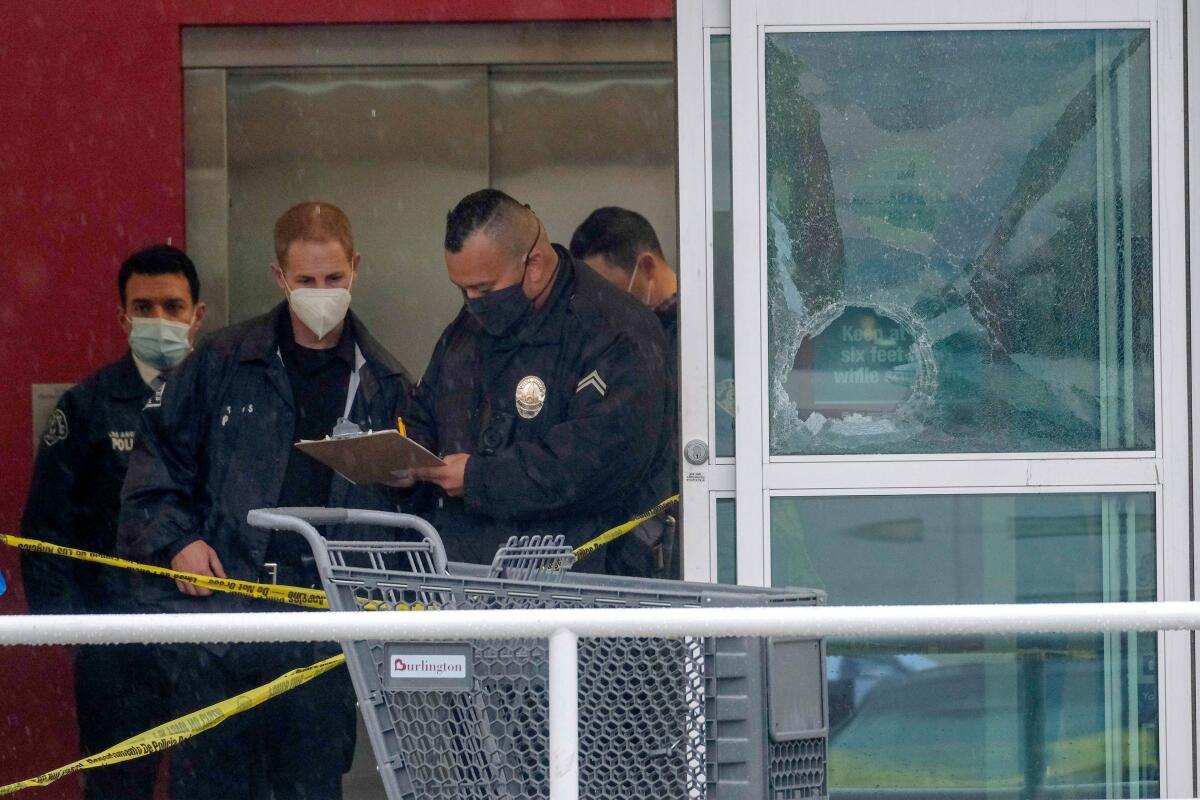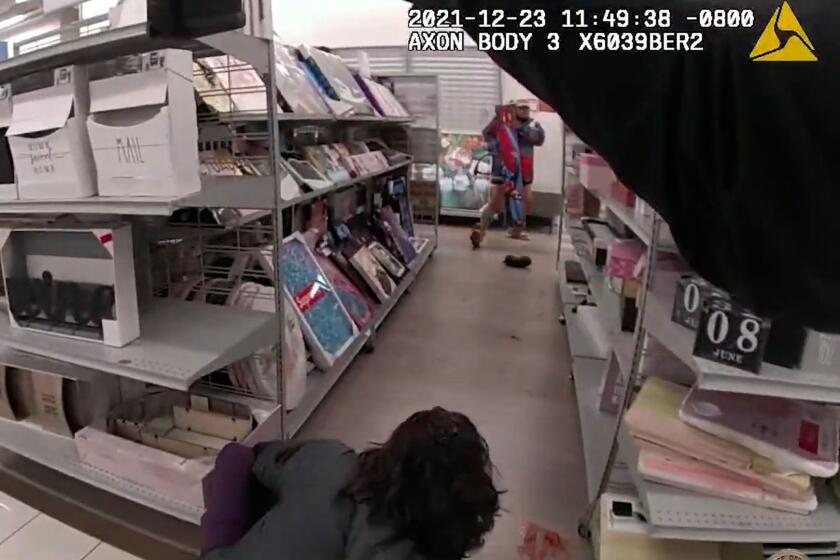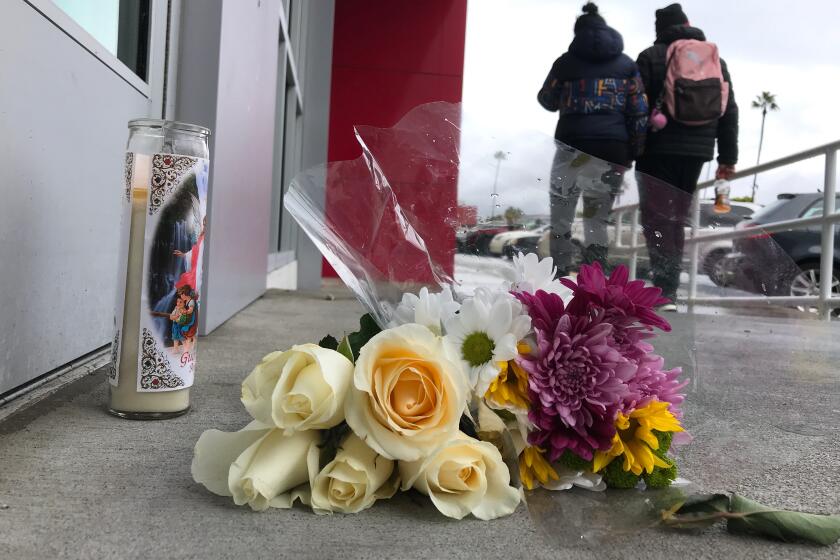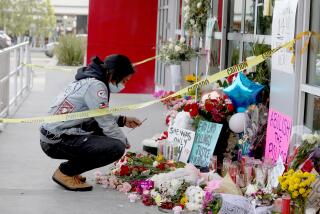Aggressive ‘active shooter’ tactics face scrutiny after LAPD kills girl at Burlington store

- Share via
The frantic 911 calls started coming in late Thursday morning from a Burlington clothing store in North Hollywood. Multiple callers said a man was threatening people inside the shop, either with a bicycle lock or a gun. At least one caller reported that shots had been fired.
Los Angeles police were dispatched, and by noon a small group of officers with guns drawn filed up the double escalator to the second floor, where they encountered and quickly shot 24-year-old Daniel Elena-Lopez, as depicted in bodycam footage released by the LAPD on Monday.
Elena-Lopez was killed, as was Valentina Orellana-Peralta, a 14-year-old trying on clothes in a dressing room nearby. A relative said she died in her mother’s arms at the store. The officer opened fire as Elena-Lopez appeared to be moving away from a bloodied woman he attacked. It is unclear whether the officers knew the suspect didn’t have a gun.
While the exact tactics used by police Thursday remain under review, they were in many ways using a playbook that has come to define police responses to “active shooter” situations in the 22 years since the Columbine High School shooting, which left 13 dead in Colorado.
In a mass-shooting scenario, officers rushing in to kill or arrest a shooter can reduce the potential death toll of a heavily armed assailant. But in cases such as the one at Burlington, where suspects turn out not to be armed with a gun, the tactic raises serious questions.
The tragedy has sparked outrage and debate over how police should respond to such incidents — especially when it is unclear whether a suspect is actually armed and firing.
The LAPD released video of the fatal police shooting inside a Burlington clothing store last week that left a suspect and a 14-year-old girl dead.
For years, the standard approach was for police to surround an active shooting scene, assess the situation and attempt to negotiate in hopes of avoiding a violent showdown. Today, police are trained to kill or arrest any shooters before taking other actions, including helping victims.
The thinking, experts say, is that by neutralizing threats, officers minimize additional casualties while allowing EMTs and medical professionals to help the wounded.
Although that approach can be beneficial when confronting an active shooter, it has serious drawbacks. Last week, Valentina’s death raised serious questions about the costs and benefits of what some advocates call “shoot first” policing.
Today’s tactical doctrine is best summarized as “stop the killing before we stop the dying,” said Sid Heal, a retired L.A. County sheriff’s commander and current chairman of strategy development for the National Tactical Officers Assn.
“We have gone proactive. The general practice is we take [an active shooter] under fire at the earliest opportunity,” he said. “It’s our nature to go to the wounded. But the problem is he can kill them as fast as we can save them.”
It’s still not clear whether the officers followed LAPD protocols in how they handled the incident, and that will be the subject of further investigation by the department.
Travis Norton, leader of the California Assn. of Tactical Officers’ after-action review team, said officers need to be better educated about the decisions they face in active-shooting situations.
“It’s all training and education. Training is the how, and education is the why. We’re well trained and poorly educated. We know how to do things but we aren’t great at explaining why,” said Norton, who has traveled widely to analyze law enforcement response to about 20 active-shooter incidents, including the Pulse nightclub mass shooting in Orlando, Fla., the San Bernardino attacks and the Pittsburgh synagogue massacre.
He said that while it may be more obvious how officers should respond to incidents in which there is live gunfire when they arrive on the scene, “it’s not so cut and dry” when there is no gunfire taking place upon their arrival.
“Everybody wants a checklist — they want 1, 2, 3, 4, 5 — but that’s not how these things work. You have to assess the situation and act based on the context of that problem you’re faced with,” said Norton, who is pursuing doctoral studies at USC focused on law enforcement response to such incidents.
And yet, he said, his research has found time and again that breakdowns in several key areas contribute to less effective law enforcement responses. Most critical is leadership problems, which arise in 93% of active-shooting incidents, Norton said.
But perhaps most important is decision-making. The initial choice about how to respond to a suspected active-shooter situation can have more of an effect on the outcome than almost anything else, he said.
“It’s great that you’re a good marksman, but what about the decision if you should even shoot in the first place?” Norton said. “We should be spending as much training time on decision-making as we are on learning how to shoot.”
Valentina’s killing sent shockwaves across not just Los Angeles but also Chile, where the girl was from. And in many corners there were angry questions about police tactics.
“How can they shoot crazy like that?” asked Graciela Cornejo, 70, who lives near the store, in an interview Friday. “They’re trained for all of this. I just can’t understand.”
Ron Gochez, a veteran community organizer and high school history teacher in South Los Angeles, said he believes the incident would have been handled differently in a more affluent, white neighborhood, with police less likely to quickly open fire in a store filled with holiday shoppers.
“I realize it was a dangerous situation,” Gochez said, “but the way the police do their business in our communities shows a total disregard for our life.”
In addition to Valentina’s shooting, he cited the LAPD’s botched detonation of illegal fireworks in South L.A. this summer, sparking an explosion that injured 17 people and damaged or destroyed dozens of residential properties, businesses and vehicles.
“The behavior of the police is just night and day, depending on what ZIP Code they are in,” Gochez said. “Their conduct would not be the same in more affluent communities.”
In a statement Monday, the League of United Latin American Citizens called for “an immediate and thorough investigation” of the shooting.
“Everything in their academy training is supposed to teach them to consider the worst-case scenario before drawing their service revolvers,” said Domingo Garcia, national president of the league. “Equally troubling is that this incident is only the latest in a rash of recent LAPD shootings involving Latinos.”
The aunt of Valentina Orellana-Peralta, who was fatally shot by the LAPD, said the 14-year-old ‘was catching up with English and being more outgoing.’
Both the LAPD and California Department of Justice have opened investigations into the Burlington shooting. Several Los Angeles City Council members have also called for a review.
The tragedy comes at a time when LAPD shootings are under growing scrutiny. Shootings by Los Angeles police officers increased this year after years of declines.
An LAPD estimate earlier this year, when police had shot 30 people, indicated about a third of them were exhibiting signs of mental illness at the time. Officers in recent years have also shot suspects at much farther distances than they perceived them to be in relation to themselves, and when they were unarmed, according to investigations.
Chris Grollnek, a retired SWAT officer and tactical expert, who was involved in a 2010 incident in McKinney, Texas, in which an attacker fired more than 100 rounds outside a police station, said that the increase in active shootings in recent years has helped spur a shift in tactics and realization that police “have to deal with the aggressor and stop him as soon as possible” to minimize casualties.
According to Grollnek, studies of active-shooter incidents have shown that an attacker can kill as many as four victims in a minute. The average police response time in major cities is about two to three minutes, he said, creating a difficult scenario in which officers have little time to react after arriving at the scene.
“They’re in a near-impossible situation,” he said of the responding officers.
Times staff writers Richard Winton, Nathan Solis and Brittny Mejia contributed to this report.
More to Read
Sign up for Essential California
The most important California stories and recommendations in your inbox every morning.
You may occasionally receive promotional content from the Los Angeles Times.















